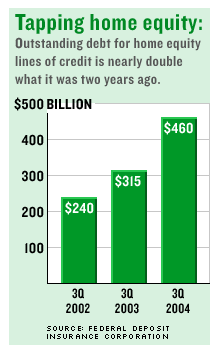BEND, Ore. (CNN/Money) – Money doesn't grow on trees. Yet, homeowners seem to think that home equity is an unlimited resource.
Outstanding debt for home equity lines of credit increased nearly 11 percent during the third quarter, according to preliminary numbers released Tuesday by the Federal Deposit Insurance Corporation.
The amount of outstanding debt for home equity lines of credit, or HELOCs, was nearly $460 billion at the end of the third quarter, a 46 percent increase from the same time in 2003.
"Homeowners have been pretty aggressive in tapping their home equity," said Richard A. Brown, chief economist for the FDIC in an interview with CNN/Money last month. In 2003 alone, they tapped more than $300 billion of home equity via lines of credit and cash out refinancing, he said, or about 4 percent of personal income. "That's a big number."
It should come as no surprise that home equity lines continue to grow in popularity. These loans, which allow you to borrow against the equity in your home any time, for any purpose just by writing a check, are cheap, convenient and widely available.
Still, the numbers are staggering.
The average line of credit available between June 2003 and June 2004 was about $77,500, according to the Consumer Bankers Association, up from about $69,500 the previous year.
On average, homeowners tapped their lines of credit five times during that period, borrowing an average of $19,162 each time.
Between June 2002 and June 2003 consumers borrowed from home equity less than four times with an average transaction of about $13,000.

With refinancing activity down this year, Brown noted, lenders have been promoting HELOCs. "Some lenders have even begun to impose fees for people who don't use their credit," he said.
The FDIC says that historically banks have not had problems with these loans, but given the rapid growth of these loans, Brown said, "it's on our radar screen."
"We're in a transition toward higher interest rates and possibly a leveling off in home prices," said Brown.
Home equity lines of credit, which are tied to the prime rate, are more expensive than they were a year ago. On Nov. 10, the Federal Reserve Board raised short-term rates by a quarter of a percentage point, the fourth such increase since June.
"Things are definitely getting more expensive," said Keith Gumbinger, vice president of HSH Associates, which tracks interest rates. The current average for a line of credit is 5.41 percent, he said, and that may not reflect the most recent rate Fed increase.
Of course, rates for home equity lines of credit are still significantly lower than home equity loans, which have a fixed rate and fixed repayment schedule. Recently rates on these loans averaged 7.06 percent, according to Gumbinger.
And, as many homeowners have discovered, using a home equity line as part of a down payment on a new home is still generally a better bet than paying private mortgage insurance, which is required if your first mortgage is more than 80 percent of the sale price.
Unlike interest paid on car loans and credit cards, interest on home equity lines and loans is tax deductible (unless you're subject to the alternative minimum tax, in which case you can only deduct interest on borrowing related to the home).
"There's no way for consumers to borrow more cheaply," said Gumbinger. "But that might change if the Fed raises rates a couple more times."

|